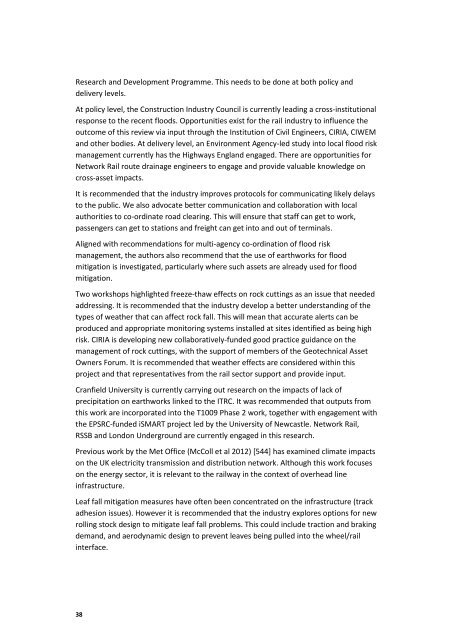Tomorrow's Railway and Climate Change Adaptation Final Report
2016-05-T1009-final-report
2016-05-T1009-final-report
You also want an ePaper? Increase the reach of your titles
YUMPU automatically turns print PDFs into web optimized ePapers that Google loves.
Research <strong>and</strong> Development Programme. This needs to be done at both policy <strong>and</strong><br />
delivery levels.<br />
At policy level, the Construction Industry Council is currently leading a cross-institutional<br />
response to the recent floods. Opportunities exist for the rail industry to influence the<br />
outcome of this review via input through the Institution of Civil Engineers, CIRIA, CIWEM<br />
<strong>and</strong> other bodies. At delivery level, an Environment Agency-led study into local flood risk<br />
management currently has the Highways Engl<strong>and</strong> engaged. There are opportunities for<br />
Network Rail route drainage engineers to engage <strong>and</strong> provide valuable knowledge on<br />
cross-asset impacts.<br />
It is recommended that the industry improves protocols for communicating likely delays<br />
to the public. We also advocate better communication <strong>and</strong> collaboration with local<br />
authorities to co-ordinate road clearing. This will ensure that staff can get to work,<br />
passengers can get to stations <strong>and</strong> freight can get into <strong>and</strong> out of terminals.<br />
Aligned with recommendations for multi-agency co-ordination of flood risk<br />
management, the authors also recommend that the use of earthworks for flood<br />
mitigation is investigated, particularly where such assets are already used for flood<br />
mitigation.<br />
Two workshops highlighted freeze-thaw effects on rock cuttings as an issue that needed<br />
addressing. It is recommended that the industry develop a better underst<strong>and</strong>ing of the<br />
types of weather that can affect rock fall. This will mean that accurate alerts can be<br />
produced <strong>and</strong> appropriate monitoring systems installed at sites identified as being high<br />
risk. CIRIA is developing new collaboratively-funded good practice guidance on the<br />
management of rock cuttings, with the support of members of the Geotechnical Asset<br />
Owners Forum. It is recommended that weather effects are considered within this<br />
project <strong>and</strong> that representatives from the rail sector support <strong>and</strong> provide input.<br />
Cranfield University is currently carrying out research on the impacts of lack of<br />
precipitation on earthworks linked to the ITRC. It was recommended that outputs from<br />
this work are incorporated into the T1009 Phase 2 work, together with engagement with<br />
the EPSRC-funded iSMART project led by the University of Newcastle. Network Rail,<br />
RSSB <strong>and</strong> London Underground are currently engaged in this research.<br />
Previous work by the Met Office (McColl et al 2012) [544] has examined climate impacts<br />
on the UK electricity transmission <strong>and</strong> distribution network. Although this work focuses<br />
on the energy sector, it is relevant to the railway in the context of overhead line<br />
infrastructure.<br />
Leaf fall mitigation measures have often been concentrated on the infrastructure (track<br />
adhesion issues). However it is recommended that the industry explores options for new<br />
rolling stock design to mitigate leaf fall problems. This could include traction <strong>and</strong> braking<br />
dem<strong>and</strong>, <strong>and</strong> aerodynamic design to prevent leaves being pulled into the wheel/rail<br />
interface.<br />
38


